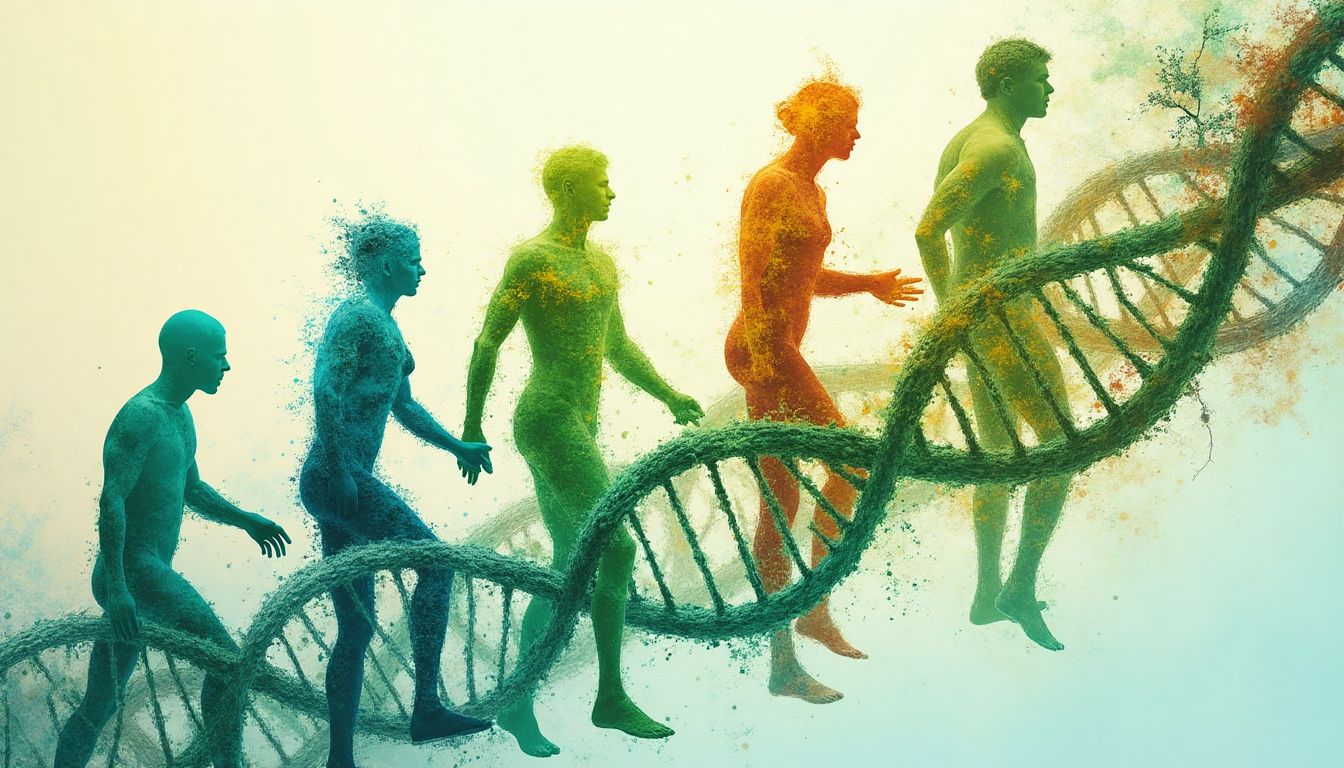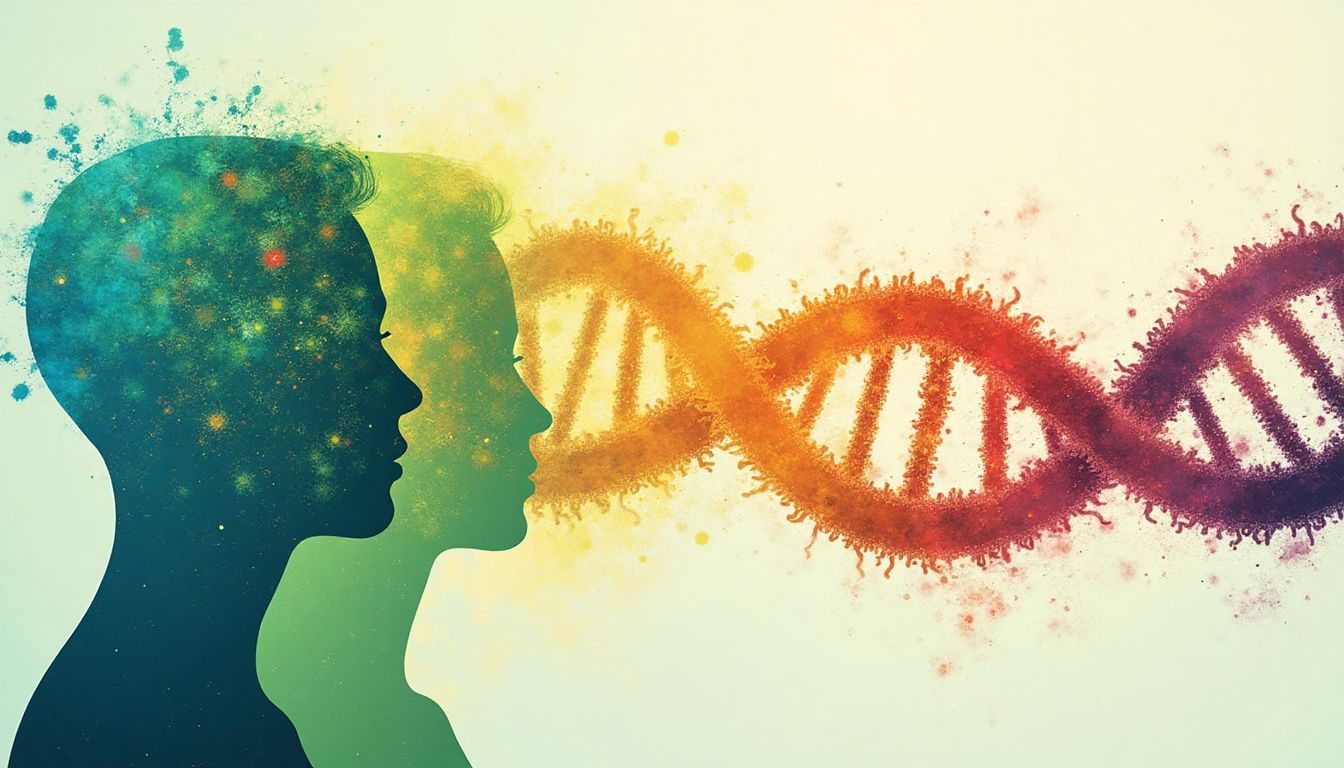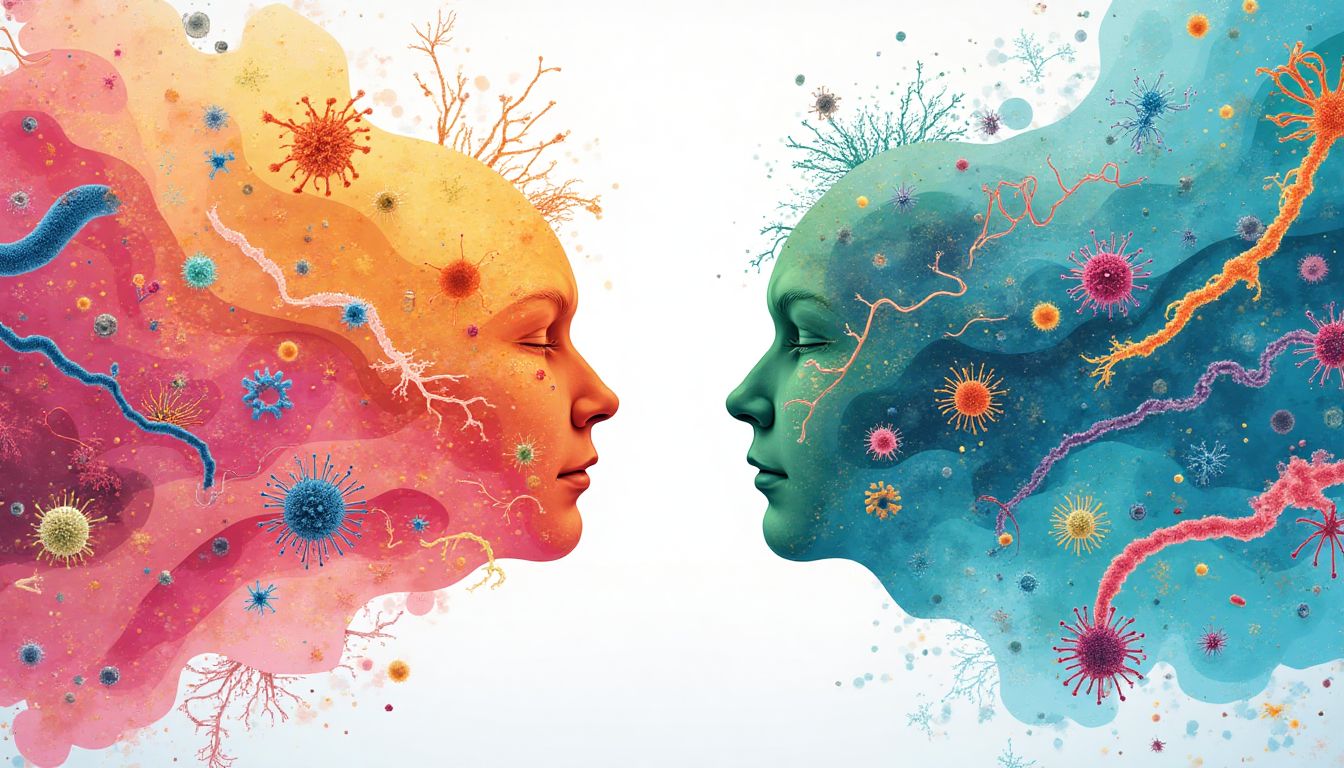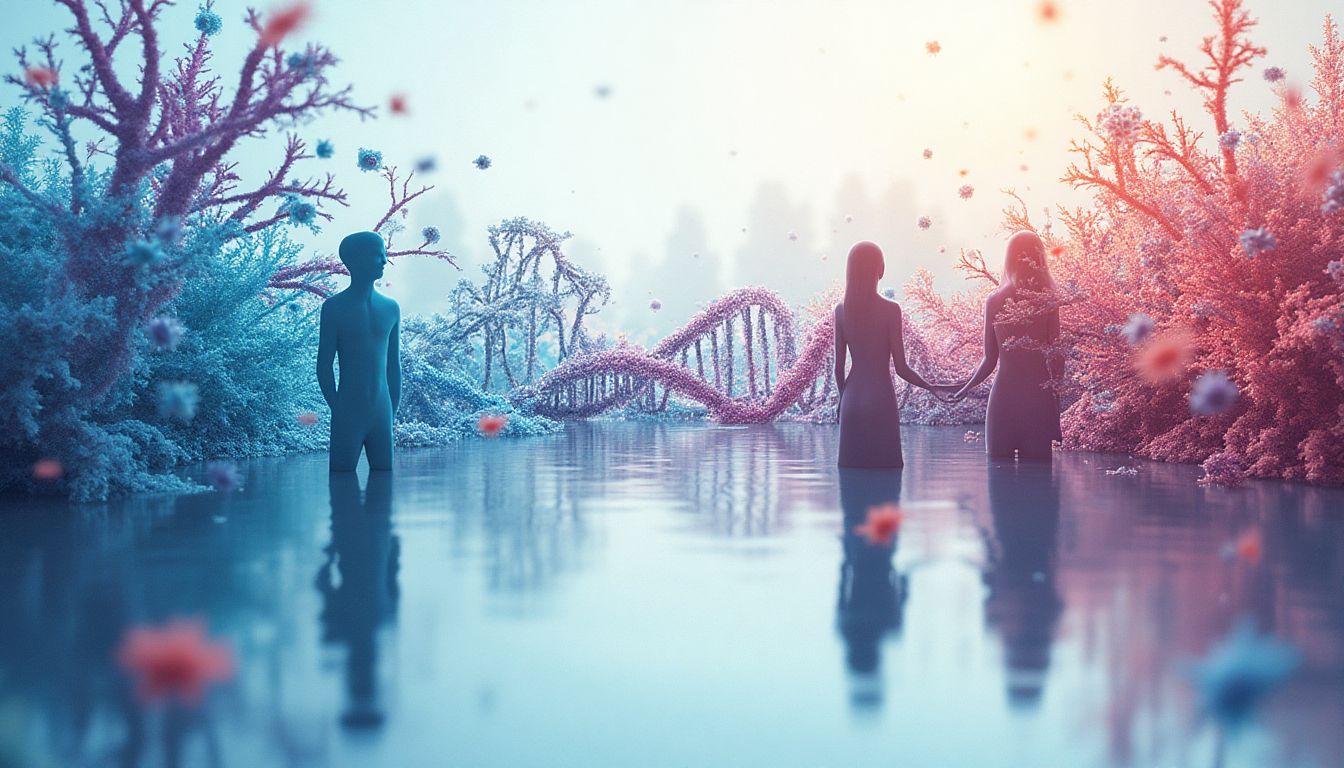Introduction: The Future is Microbial
To know the road ahead, ask those coming back. - Chinese Proverb.
In the journey of human evolution, the road is paved with countless interactions with the microbial world. Sometimes we perceive microbes as foes, steering clear to avoid illnesses. Yet, do we ever stop to ponder the mysteries hidden in their seemingly simple existence? What if I told you these unseen companions are not merely invaders but architects in our biological blueprint? Our relationship with them tells an awe-inspiring tale of mutual dependency.
Researchers like Rachel Carson awakened us to nature's intricate webs, while Edward O. Wilson reminds us of biodiversity's hidden secrets, and Carl Zimmer writes beautifully about our entanglement with the microbial world. It's time to unravel how our tiny neighbors hold the keys to our survival.
The Co-Evolution of Humans and Microbes
The dance between humans and microbes has spanned millennia, evolving from a simplistic battle to a sophisticated ballet. The narrative began with us seeing microbes merely as threats. However, this story, like any gripping tale, has evolved. To truly appreciate it, we must first dive into its origin story.
The Origin Story: Imagine a time when humans first encountered microbes. Our prehistoric ancestors interacted with the microbial world, unknowingly forging partnerships that would shape their descendants' future. These microscopic entities colonized our bodies, turning us into teeming planets within planets.
How did this come to pass? As we evolved, so did they—a parallel journey intricately intertwined. Our ancestors, braving wild environments, likely embraced symbiotic microbes out of sheer necessity. Over generations, these microorganisms etched their presence in our gut, skin, and more, evolving alongside us. Today's scientists, marveling at human resilience, unearth these connections like anthropologists uncovering ancient artifacts.
Mutual Beneficial Relationships: A shining example of this harmony is the gut microbiome. Tasked with breaking down food, these commensals grant us nutrients—an efficient partnership. But that's not all. They play the role of vigilant guardians, training our immune systems and even influencing our moods.
Picture a microbial world under siege by antibiotics, only to rise like a phoenix in times of harmony. This ebb and flow, a testament to mutual evolution, is brought to life through captivating case studies. From scientific research to anecdotes that warm the heart, we uncover these beneficial microbial alliances within our own bodies.
These stories invite us to rethink: what if understanding and optimizing our microbial guests could redefine what it means to be human? As we continue this exploration, let's keep our minds open to the possibility that our allies in the microbial world might just be the heroes of our evolutionary saga.
Understanding Microbial Symbiosis
Perhaps you’ve wondered why your body isn’t just a solo show? Well, it seems we’ve always been in a cosmic collaboration! Microbial symbiosis isn't just a tongue-twister reserved for scientists, it’s the undercurrent of human health. Imagine it like a dance floor of life, where microbes and humans sway together. Sometimes it's a beautifully coordinated waltz; other times, it’s like us attempting the cha-cha after one too many sodas!
- 2.1 Types of Symbiotic Relationships: Within this dance are varied steps—parasitism, commensalism, and mutualism. Parasitism is like the old movie trope where one partner thrives at the expense of the other (think of leeches in a harsh, chaotically suited environment). Commensalism is the humble napkin, where one partner benefits without affecting the other—like those quiet kids at parties sipping punch. And then there’s mutualism, the strong high-five: both parties benefit, and everyone wants a repeat!
- 2.2 The Microbiome's Role: Your microbiomes are nothing but grand arenas hosting billions of microorganisms, battling and ballrooming right within you. Whether it’s the gut, skin, or oral microbiomes, these tiny citizens help digest food, protect against infection, and even regulate mood. Essentially, your microbiome could have its own sitcom, and you—inadvertently—are its star! Yet, disruptions, like any drama series, can spell chaos, leading to health issues like obesity or even depression.
Our allies in lab coats are racing against time, investigating these fascinating relationships. It's like they're about to crack the code of a new reality series where you're cast as the hero—the protagonist in a grand epic, dancing alongside your tiny co-stars.
The Breakthroughs in Genetic Engineering
Now, cue the futuristic music, and enter stage left: GE—genetic engineering. Just like a master chef tweaks secret recipes, genetic engineering allows scientists to fine-tune microbes to foster even stronger alliances. Forget what you’ve seen in sci-fi movies; our reality is much cooler and a lot less melodramatic. Imagine if Tony Stark decided to swap building Iron Man suits for manipulating gene sequences. Yeah, genetic engineering is about that cool.
- 3.1 CRISPR Technology: Allow me to introduce you to CRISPR, the trendy magical scissor of the gene world. Partnering with beneficial microbes, CRISPR editing is the hot tool in the biological toolkit—it snips, edits, and perfects microbial DNA to make it an ally rather than adversary. Whether it’s fighting off cancer, curbing lactose intolerance, or creating microbes that clean up messes like a proactive robot vacuum, the possibilities are plenty.
- 3.2 Case Studies: Take, for instance, the modification of Lactobacillus, a darling of the probiotic realm. By fine-tuning its genes, scientists have managed to supercharge some probiotic strains that are not just good but superhero-worthy in enhancing digestion and battling gastrointestinal bullies. Look up to more ideas like these and you’d see they’re not just ideas on paper, but also stars on the stage of reality, crawling and transforming our future narrative.
However, raising these genetic alliance isn't without its ethical musings—conversations debated over coffee and at conferences. It's a tightrope walk between healing and overstepping, and regulatory frameworks are our safety nets. They ensure we don’t tip into realms better left within the confines of fairy tales and speculative fiction. Like any thrilling ride, genetic engineering offers both exhilaration and caution—a future too electric to ignore.
Potential Applications for Human Survival
The marriage of genetic engineering with microbial symbiosis offers the tantalizing prospect of revolutionizing various sectors pivotal to human survival. Imagine a world where engineered microbes not only heal our bodies but also help feed us and sustain our environment.
Agriculture: Breakthroughs in this area could mean engineered microbes enhancing crop resilience. In the face of climate change, genetically-modified symbionts can be designed to protect plants against pests and diseases, improving yields. For instance, microbes that boost nitrogen fixation can reduce the need for harmful chemical fertilizers, leading to healthier crops and a cleaner planet.
Medicine: In healthcare, the advent of custom-created probiotics could be game-changers. Such probiotics, imbued with specific health-enhancing traits, can target and rebalance human microbiomes. Conditions like autoimmune diseases and allergies could be mitigated or even prevented as these engineered companions restore harmony within our digestive systems.
Let's break down these ideas into better chewable morsels:
- Engineered microbes can:
- Enhance crop resilience
- Reduce dependency on chemical fertilizers
- Improve health outcomes through bedazzled probiotics
The potential applications of these microbial wonders are vast, yet, it's crucial to juxtapose these hopes with the challenges that come with implementing them in real-world settings. Regulatory hurdles, consumer acceptance, and the readiness of infrastructures to handle these new-generation solutions need attention. Creative efforts to engage these issues are like tuning a delicate orchestra, ensuring every section plays in harmony.
Ethical Considerations and Future Prospects
As we forge ahead, tinkering with life's fringe elements, ethical considerations shape the very heart of this genetic odyssey. The delicate balance of utilizing this technology for the greater good without crossing into the realm of exploitation is a key challenge.
Ethical Dilemmas: Venture into genetic symbiosis and one encounters myriad ethical debates. Is it right to alter the blueprints of life to enhance one species? Questions abound on the long-term ecological impacts and the potential unintended consequences. The line between therapeutic benefit and genetic exploitation must be vigilantly guarded.
Future Directions: Despite the hurdles, the horizons of genetic symbiosis glimmer with promise. The possibilities are as expansive as human creativity. Research will likely expand, exploring uncharted terrains of microbial partnership. As these delicate dance steps evolve, society might witness untold transformations in health, agriculture, and sustainable practices.
Envisioning future prospects involves a creative exploration of novel directions and possibilities:
- How might society embrace genetically engineered microbes?
- Sustainable practices could flourish, influenced by society's evolving sensibilities.
- Biotechnological advancements transforming public health and wellness standards.
Our voyage into the frontier of genetic symbiosis beckons sophisticated communal discussions on regulatory wisdom, ethical frameworks, and responsible innovation. As dreamers and pioneers, the road ahead challenges us to craft a clockwork symphony of human intellect, empathy, and ecological consciousness.
AI Solutions: How Would AI Tackle This Issue?
Artificial Intelligence (AI) is revolutionizing many aspects of science and technology, transforming how we interact with our environment, and even with tiny companions like microbes. In the realm of genetic symbiosis, AI is not just a tool; it can become the guiding star leading us through the complexities of microbiome research and engineering. Here’s how AI can radically redefine the landscape of human-microbial interactions.
- Predictive Modeling: AI can use machine learning algorithms to analyze vast datasets acquired from microbiome studies. By employing predictive modeling, researchers can anticipate how specific microbial interventions might affect human health. For example, studies have shown that using AI algorithms can predict the responsiveness of individual microbiomes to different probiotics, paving the way for personalized treatments that consider genetic makeup, dietary habits, and lifestyle factors. Several advancements in this area have been spearheaded by experts from Harvard Medical School and other institutions.
- Personalized Medicine: Imagine a world where patients receive tailored probiotic treatments based on intricate analyses of their individual microbiomes. Advanced AI can facilitate this personalization, identifying specific microbial species that would provide maximum health benefits without causing adverse effects. Recent findings from studies published in the Nature journal reveal that AI and microbiome analysis can be combined to develop targeted therapies, thus transforming our health strategies.
To realize these AI-driven innovations, we need a clear action schedule—a roadmap that guides collective efforts over time, directed towards integrating AI and microbial engineering.
Action Schedule/Roadmap (Day 1 to Year 2)
Day 1: Assemble a multidisciplinary team comprising microbiologists, genetic engineers, data scientists, ethicists, and AI specialists. The goal is to foster collaboration and ensure diverse perspectives.
Day 2: Conduct an extensive literature review on existing microbial and genetic engineering practices. Understanding the current landscape is essential before embarking on experimental endeavors.
Day 3: Identify key microbial strains with potential benefits for human health, focusing on previously unstudied environmental microorganisms. This will involve databasing their genetic information and studying their functionalities.
Week 1: Set up laboratory protocols for employing CRISPR-based genetic editing on selected microbial strains. The aim is to introduce modifications that enhance their beneficial properties.
Week 2: Initiate preliminary trials to test the efficacy of genetically engineered microbes in controlled environments, such as laboratory animals or bio-simulators designed for microbiome studies.
Week 3: Begin collecting data on microbial interactions with host organisms, incorporating AI models to analyze real-time outcomes and provide forecasts on health implications.
Month 1: Analyze trial results through AI-assisted data analysis. Optimize the strains based on findings, adjusting genetic edits as necessary.
Month 2: Forge partnerships with agricultural and medical sectors for pilot studies. This will ensure practical applications are aligned with market needs, addressing real-world health and food security challenges.
Month 3: Organize community seminars, inviting public input and open forum discussions about the research. Increased transparency will foster trust and awareness regarding microbial innovations.
Year 1: Launch the first round of engineered microbial applications in controlled environments. Gather longitudinal data to analyze the long-term effects of these microbes on health and environmental conditions.
Year 1.5: Document extensive case studies demonstrating the outcomes of microbial interventions, sharing results with the broader scientific community to facilitate knowledge sharing.
Year 2: Expand research scope based on findings, advocate for regulatory frameworks to govern the responsible use of genetic engineering in microbes. Pursue collaborations with relevant organizations such as the World Health Organization (WHO) and National Science Foundation (NSF) to elevate global awareness and engagement.
Conclusion: A Future United by Microbial Harmony
The relationship between humans and microbes represents a captivating intersection of science and potential. As we continue to navigate our evolving understanding of this complex partnership, there is a profound opportunity for collaboration. With the advances in genetics and the power of AI fueling our journey, a clearer path to enhancing health and sustainability emerges. These microbial allies could guide us into uncharted territories, promoting resilience and vitality as we strive to balance our existence with these inconspicuous yet vital companions. It is crucial that we approach this adventure not just with optimism but also with prudence and ethical consideration. Through conscientious exploration, we can unlock the secrets of genetic symbiosis, clear a way for healthier futures, and champion the cause of flourishing human-microbial coexistence.
Frequently Asked Questions (FAQ)
Q1: What are microbial symbionts?
A1: Microbial symbionts are tiny living organisms, like bacteria and fungi, that live closely with larger organisms, such as humans. They help out in many ways, like aiding our digestion or keeping our skin healthy. This connection is super important for our overall well-being. For more information on microbiomes, check out the National Institutes of Health.
Q2: How does genetic engineering affect microbial communities?
A2: Genetic engineering can change how microbes act. Scientists can make helpful bacteria even better by tweaking their genes. For example, they can increase a microbe's ability to fight off harmful bacteria or make it produce beneficial substances. This can lead to a healthier gut or stronger immunity. If you're curious about the actual processes, you can learn more from GenomeWeb's guide on CRISPR.
Q3: Are there risks associated with genetically engineering microbes?
A3: Yes, there are some risks. Sometimes, when we change a microbe's genes, it might start acting unpredictably. This can affect not just individual health but entire ecosystems. There’s also the concern about how this genetic modification could be used or abused. It’s important for scientists to study these risks closely to prevent negative effects. You can learn more about the implications of genetic engineering from BBC Future.
Q4: How can AI contribute to microbial studies?
A4: Artificial Intelligence (AI) is like a super-smart helper for scientists. It can analyze huge amounts of data really quickly to find patterns in how microbes behave. With this info, AI can help design personalized medicine based on each person's unique microbiome. This means treatments can be tailor-made to fit individual needs! To find out more about the current trends in AI applications, take a look at MIT Technology Review.
Q5: What is the future outlook for genetic symbiosis?
A5: The future looks bright for genetic symbiosis! As we learn more about how we can work together with microbes, we may find exciting breakthroughs in health and agriculture. This could lead to improved food security, better health outcomes, and even sustainable practices for the planet. Organizations like World Health Organization (WHO) are actively researching these topics, so stay tuned for new developments!
Q6: Can we live without our microbes?
A6: Not really! Our microbes play key roles in keeping us healthy. If we lose them, we might face serious health issues, like digestion problems or weakened immunity. Our bodies have evolved with these creatures, and they are vital companions in our journey through life!
Q7: What can I do to support healthy microbes in my body?
A7: You can help your microbiome stay healthy by eating a balanced diet rich in fruits, vegetables, and fiber. Staying active and getting enough sleep also supports their well-being. Some people even take probiotics, which are live bacteria that can help replenish good microbes. For more tips, check out the Harvard Health Blog.
Q8: Where can I follow the latest news on microbial studies?
A8: There are many great sources to keep up with the latest in microbial research. You can follow organizations like the American Society for Microbiology (ASM) or respected journals like Nature Microbiology for the newest insights and breakthroughs in this field!
Disclaimer: This article may contain affiliate links. If you click on these links and make a purchase, we may receive a commission at no additional cost to you. Our recommendations and reviews are always independent and objective, aiming to provide you with the best information and resources.
Get Exclusive Stories, Photos, Art & Offers - Subscribe Today!




























Post Comment
You must be logged in to post a comment.